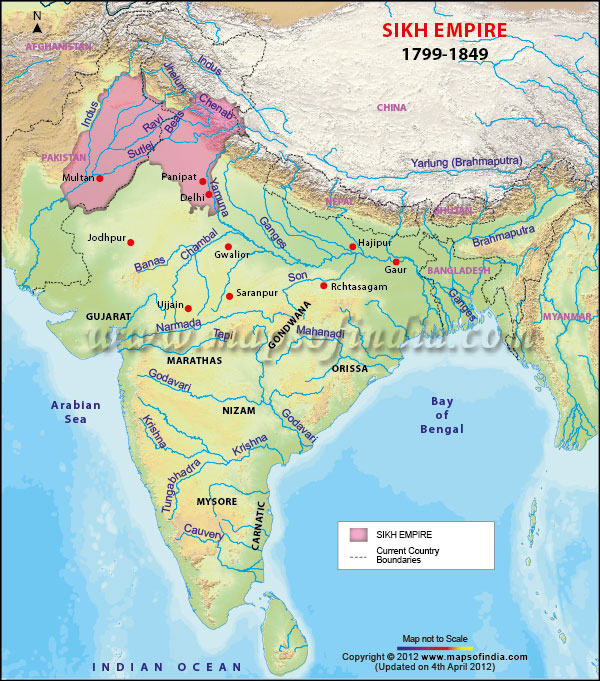Basically an imperial power, in the Indian Subcontinent the Sikh empire was concentrated around the Punjab region. The Sikh Empire began from 1799 and lasted till 1849.
The Sikh Empire forged upon the basic origins of the Khalsa. It was headed by Maharaja Ranjit Singh, who used a number of autonomous Punjabi Misls. In the 19th century, the Sikh empire was seeing its peak time and so it focused on its expansion. Hence it extended from the Khyber Pass in the west, to Kashmir in the north, to Sindh in the south and Tibet in the east.
The Sikh Empire can be traced from as early as 1707 when the last Mughal ruler Aurangzeb died and the Mughal Empire began to decline. The Khalsa Army, known as the Dal Khalsa took opportunity of the Mughal fall and Guru Gobind Singh inaugurated a rearrangement of the Khalsa in order to launch expeditions against the Mughals and the Afghans. Hence the army grew in and gradually split into semi-independent "Misls" (sects or groups). Different individual Misls had different areas and cities under their control.
When these "Misls" merged under Ranjit Singh, the Sikh Empire is believed to have started then. It was on 12 April 1801 (the date was to coincide with Baisakhi intentionally) that Ranjit Singh was crowned. The coronation was conducted by a descendant of Guru Nanak Dev, Sahib Singh Bedi. From a mere leader of a Sikh Misl, Ranjit Singh had become the Maharaja of Punjab, in a short span of time. Under his rule the army began to modernize, with the implementation of the latest training as well as weapons and artillery. The Sikh empire weakened way too much after the death of Ranjit Singh, the main causes being internal divisions and political mismanagement. It was in 1849 that the state, after their defeat in the Anglo-Sikh wars, dissolved. For about 50 years (from 1799 to 1849) the whole of the Sikh Empire was divided into four main parts, whih are: Lahore, Multan, Peshawar and Kashmir.
A Hindu ascetic namely, Banda Singh Bahadur on meeting Guru Gobind Singh at Nanded converted to Sikhism. Guru Gobind Singh just a few years before his death had sent a letter to him ordering to re-conquer
Punjab and commanded the Sikhs to join him. After Banda Singh Bahadur gained support he initiated an agrarian uprising which broke the large properties, lands and estates of the Zamindar families into small parts and distributed this segmented land to the poor Sikh, Hindu and Muslim peasants who used the land for agriculture.
t language="javascript" type="text/Javascript">Instructions();

